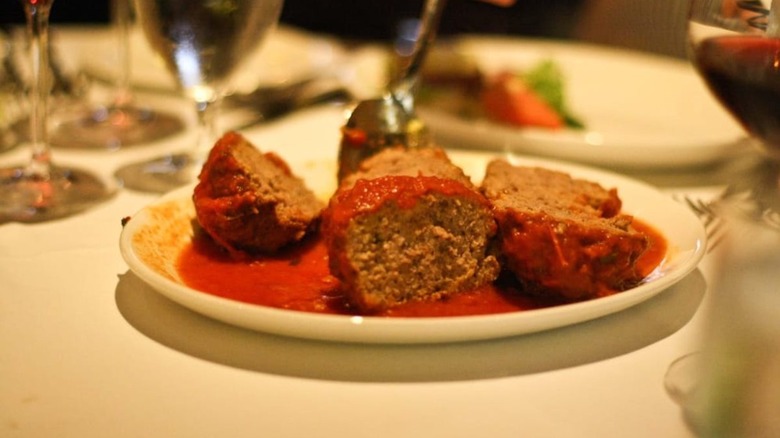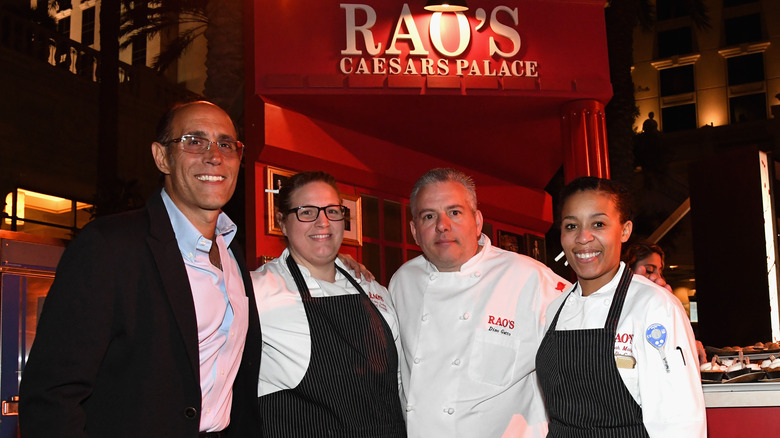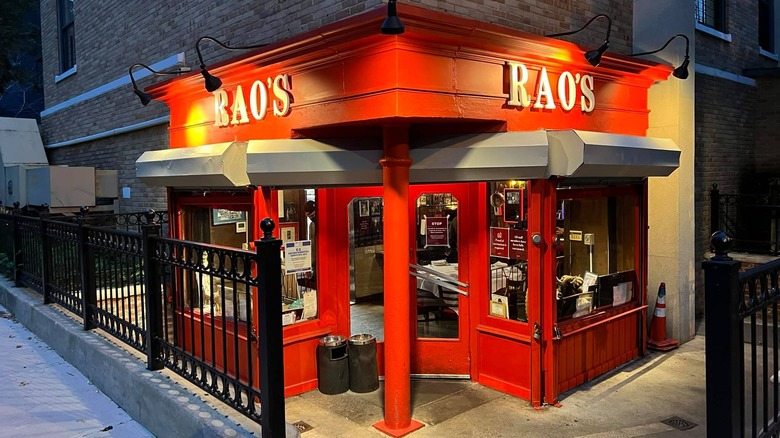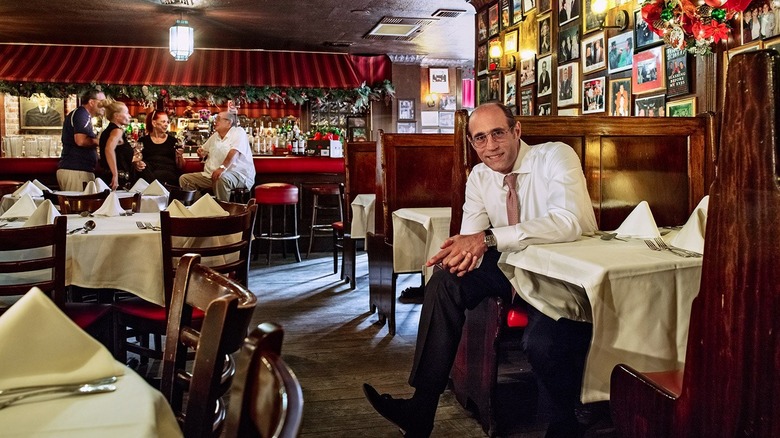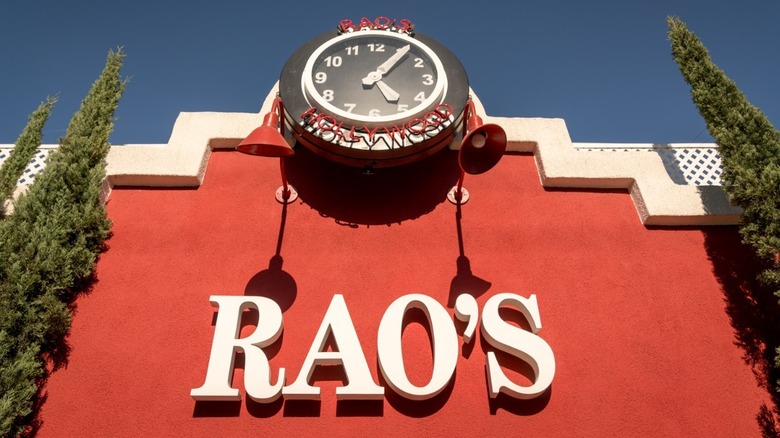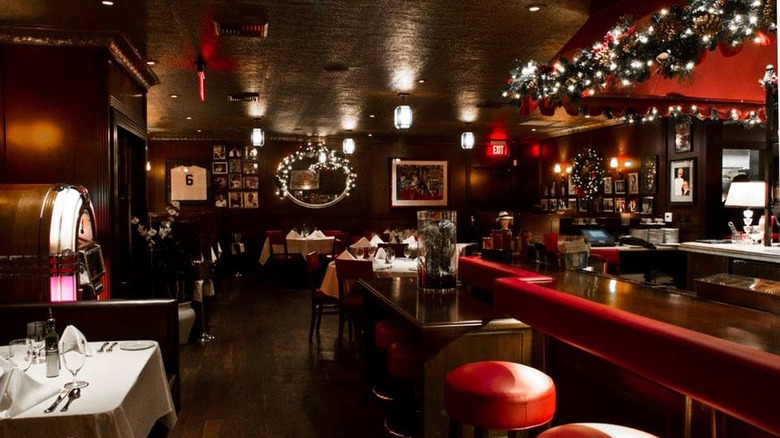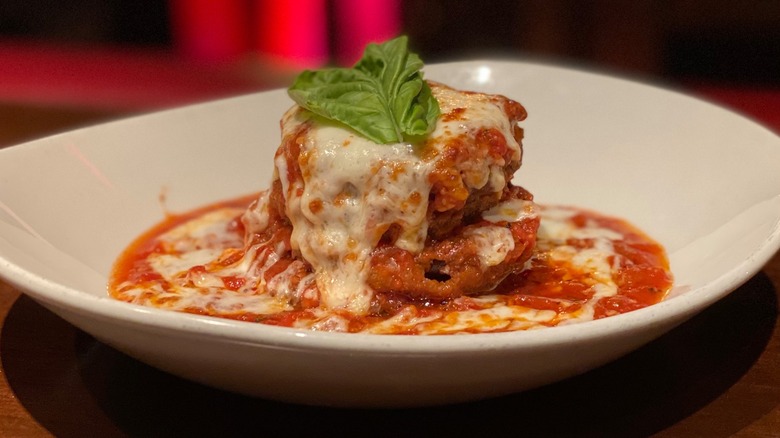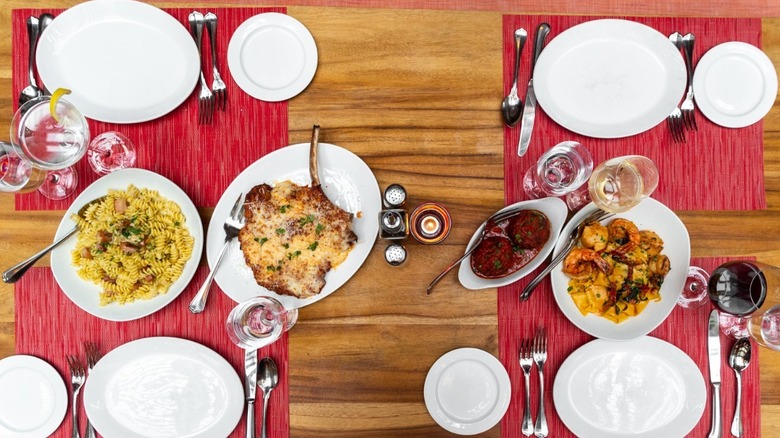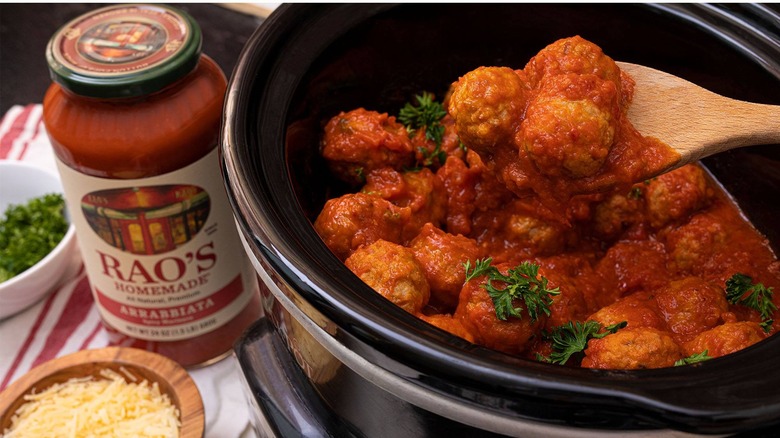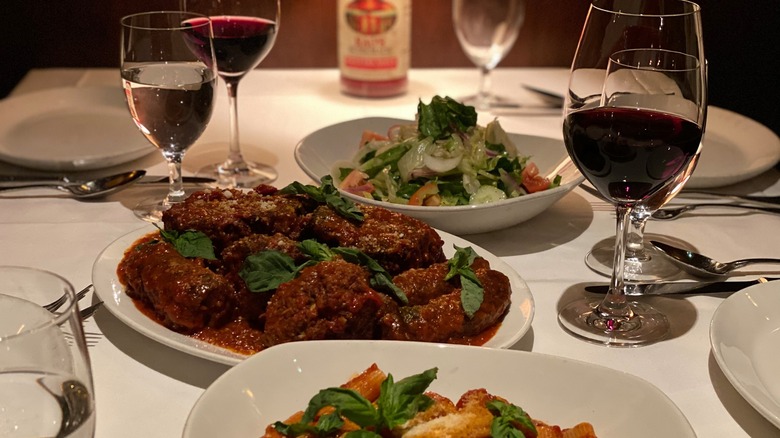Rao's Owner Frank Pellegrino Jr. Reveals The Key To Being Successful In The Restaurant Industry For Over 100 Years - Exclusive Interview
We may receive a commission on purchases made from links.
Everyone has heard of Rao's, but not many can say they have been inside those famous doors –- that's because its original New York City location has just 10 tables. For 125 years, the legendary Rao's has set the bar for Southern Italian food in the United States with their famous meatballs and long list of celebrity clientele. If those walls could talk, right?
Amongst a cozy, welcoming setting they bring a piece of the old world to modern times as they truly embrace the heart and soul of Italian cuisine. Christmas strings lights are up year-round as you hear the crooning of Frank Sinatra in the background. One could even say that time stands still inside Rao's.
Its shortlist of regulars have held standing reservations for years, some even decades — because dining at Rao's is like being with family. In an exclusive interview with Mashed, chef and co-owner, Frank Pellegrino Jr. recently spoke with us about all things Sunday Gravy, sauce, and success. As the fourth-generation owner and author of "Rao's On The Grill" and "Rao's Classics," there is no one better to explain how they have organically created this utterly unique and dare we say non-replicable restaurant experience. They have since expanded to a Hollywood location that's a near-identical version to the original, but they have done all that by managing to stay true to their roots. Here's the secret behind catching lightning in a bottle — or is it a jar of sauce?
Frank Pellegrino Jr. was destined to work in the restaurant industry
Did you always know that you wanted to go into the restaurant business?
I started working at the restaurant when I was 12 years old. I completed the sixth grade and I was looking forward to this spectacular summer of BMX bicycling, beach, and friends. And the day I brought home my report card, my father said, "Frankie, I got great news for you. Guess what? You're coming to work with me." So, I was basically indentured into my work at Rao's at a very young age. And as I was growing up within the restaurant, I had the incredible opportunity to meet so many people from so many different walks of life that actually had an influential impact upon me. For the first time in my life, like, "Oh my God, a lawyer. What's a lawyer?" or, "What's an investment banker? What's this? What's that? Oh my God, this guy's an artist. Have you seen his work?" Lo and behold, it's LeRoy Neiman. And then all of a sudden, things start to spark and in different places and certainly curiosity and interest takes you on your own path, so to speak.
But at the end of the day, I pursued other career paths, but also participated in the restaurant, even when it appeared that I was trying to escape from the restaurant. So, I was never successful, but I had the opportunity to experience a lot of incredible opportunities and other livelihoods that were pursuable by me, particularly in the world of art and communications, graphic design, fine art, and things like that. Ultimately, I finished my education at The School of Visual Arts while I was still working in the restaurant.
You are the fourth-generation in your family to run Rao's, did they pass you down any tips or wisdom?
I was groomed for this job, probably starting very early in my life. And oddly enough, it all centers on Sunday gravy. I grew up in my grandmother's house and in her kitchen, ever since I was a little boy. And my grandmother's house was like a restaurant in and of itself. I mean, people were coming and going almost 24 hours a day. There was always a pot of coffee on the stove or in the percolator. There was always sandwiches ... food. The minute you walked in the house, "You hungry? You want me to make you a dish of pasta?", this, that, and the other thing.
So as a young boy, I experienced that my whole life growing up. And when I started to work at the restaurant, my father basically said to me, "You treat everybody who comes into this house as though they're coming to your grandmother's house. Okay? These are all friends, family, and you just do your job, treat everybody ingratiatingly, embrace them, be polite and keep quiet." That was the story of my childhood and eat well.
How Rao's preserves history while keeping up with dining trends
Do you feel any pressure to adapt or change things on the menu because of current trends?
Yes. All cuisine is subject to the times and present day. Just look at the efficiencies that have come about over the last 20 years. Products that you couldn't get before are now readily available in the supermarkets. There's not that challenge of trying to resource ingredients that are really hard to find. And then ... The evolution of supermarkets and mega supermarkets, like Whole Foods and such, I think allowed everybody, from the home cook to chefs, the ability to call better ingredients, more quality ingredients, unique ingredients that you may not have had the opportunity to experience before, but now can, and you take them and make them a part of your repertoire, culinary vocabulary, what have you, and you go, "Oh, my God. This would taste great with this preparation or recipe. Let me try it."
And hence, there comes your evolution of the dish, the food, and what have you. Same thing with when you go from a restaurant that does 65, 70 covers a night, and everything's prepared on the new, to a restaurant where you're doing 500 plus covers a night where you have to have the epitome of efficiency in order to prepare for that service for the evening. Yes, you have to streamline, primarily by doing things in preparations in large quantities, and what have you. And you find ways to become more efficient and save more time ... But to simply answer your question, yes, dishes evolve, recipes evolve, and so long as they're better than what they were before, that's okay.
If not, we stay with the tried and true and we don't deviate from it. And then the other part of your question is, well, what about our guests' palates? How have their palates evolved over the last 20 years? And what are their conceptions of what Italian food should be? Because not everybody gets to experience Rao's and its form, so to speak. And so, you have to be sensitive to what they're looking for as well. And then you go back to the classical family or classical Italian recipes, and then you start to put together the puzzle of how can we make this readily available for our guests and you endeavor upon it. And lo and behold, it manifests itself.
Why it's nearly impossible to land a table at the original Rao's location
Can you spill the beans for our readers on how to get a table?
So, let me give you the macro global perspective. Rao's in New York City only has 10 tables. There are six booths of four people, and then there's four tables of six. That's it. Rao's really gained its culinary notoriety back in 1977, when Mimi Sheraton from the New York Times gave the restaurant a three-star review. We were going on vacation right when that piece ran in the Times. What we didn't anticipate was the deluge of calls for reservations, requests for reservations, and what have you. And quite frankly, my dad was overwhelmed by it and knew he had a dilemma on his hands because the success and sustenance of the restaurant on 114th Street was all predicated upon the neighborhood. And [that] brings us to the turn of the century when East Harlem was the largest populated area of Italian American immigrants in the entire country, only followed by Chicago.
Those are the people that my family came over with that ultimately became the patrons of Rao's Bar and Grill back in the day. And my father refused to displace them for new business. So at least 60% of those tables in the restaurant were already accounted for, so that only left you with 40%, which is basically four tables to get reservations to. And so that's how he moved forward. And the other thing you have to keep in mind is that the restaurant was always closed on weekends, so it was a five-day week operation. So there, again, your ability to service more guests has been reduced and surely enough, the people who committed to regular tables outside of that 60%, maintain those tables for decades. We have guests right now that have been coming to our restaurant for 50 years.
Everyone that comes to Rao's is treated like family
What sets Rao's apart from other decades-old restaurants?
It's crazy. Customers become part of your family. They're friends. I mean, it's real. And that also sets the standard for what we do anywhere else in any of the other restaurants. Because if my dear friend Susan, who has been coming to the restaurant for 35 years, goes to the Los Angeles spot, you bet your bottom dollar that if it ain't right over there in Los Angeles, Frank Jr's going to hear about it and I better do something about it to correct it. So there's that synergy that just really was an undocumented plan that worked and out of respect, appreciation, and gratitude for the people who made Rao's what it is today. It's interesting.
I have been bestowed this incredible honor of being one of the owners of Rao's restaurant, 125 years old. Growing up in that restaurant and the time that has passed, I had come to realize that this is a place that can never belong to just one person or two people. It's a place that is owned by all of the people who supported it. It is through their loyalty and goodwill and maintenance of making their weekly reservation or their monthly or bimonthly, quarterly reservation that just sets our standard and bar in a different place than perhaps some of our contemporaries, who I have tremendous respect and appreciation for.
And a lot of those contemporaries are dear friends and also friends and patrons of the restaurant. There are some, I call them mega chefs who are deserving of such a title, who would come to the restaurant when they were starting out and come sit and chat with my dad. It's astounding. It's through those building of friendships, acquaintances turning into friends and what have you, that really is the lifeline of what the restaurant is about. The people who work and the team in New York, I think, geez, 95% of our staff has been there for decades, at least two decades, three in some cases. In my case, four. That's how old I am. But the guests come through the door and they're excited to see Dino and Tommy and Joe and Dee behind the bar.
Opening a Hollywood location was a natural progression
What was the catalyst for opening up a Los Angeles location?
As a little boy, I always had these aspirations of going out west. I was infatuated with California. And we have a dear friend of ours who ultimately is one of my partners in the Los Angeles restaurant. I'm going to leave his name out because I didn't speak with him about this and I don't know if he wants that out in the public.
But a great guy who's in the hotel, hospitality business, et cetera. And he developed a friendship with my dad, he's a little bit younger than me, before my dad had passed. And he offered us an opportunity in a hotel that he had purchased in South Beach. And so my dad and I went down to take a look at it and at that time, it wasn't right for us for numerous reasons. However, our friendship kept going and one day my friend came to me.
He was like, "Well, come on. What's next? What do you want to do?" I said, "You know what? I would really love to do something in Los Angeles." He says, "I'm up for it." And then lo and behold, as simple as that, we started to look for spaces. And let me tell you, it was a challenge to find a space in Los Angeles. And my partner got wind of this space, which was 1006 Seward Street in the old Hollywood Canteen. And we went in there and this place was utterly disheveled. And we said, "You know what? The building's turn to the century. It's definitely a destination spot because nobody in their right mind's coming over here." If you went back there eight years ago, that was a real shaky part of town. And thankfully, with all of the regentrification and what have you, that's changing, which is a wonderful thing for that area of Hollywood. We found the place. The economics seemed to be right. And we said, "Let's do it." And, basically we rebuilt the place from the foundation up.
Here, we're dishing out the hospitality the way we do in New York. It's real. It's authentic. You can't make it up.
Each Rao's encapsulates the brand's distinct vibe and look
How do you bring that same feel to all your Rao's restaurants?
EDG was the design firm who did our Vegas spot. And in order to execute the Vegas venue here, they went into the New York City restaurant and they digitized every square inch of it so that we could replicate it in its best form and format in Las Vegas. We had a seven plus million dollar build in this 10,000 square foot place that we have at Caesar's Palace. We had all of the woodwork done, milled and what have you, the cherry wood, every attention to the design decor and materials, furniture, fixtures were as identical as they could be to the New York restaurant, same design team, same thing in Los Angeles.
As simple as the place looks in Los Angeles, there was an awful lot behind it and an awful lot of quality craftsmanship and a lot of attention to detail, even though it looks very simple and basic.
Are you the one behind the song selections on the restaurant jukebox?
We all are as time evolved. My dad was a singer and an entertainer, and you might even be able to go on YouTube and see a rendition of my father singing "My Girl" or something like that inside the restaurant. It was a real ruckus. And that's also really a wonderful demonstration of the spirit of what Rao's is and the festivities that magically come about there in New York and Los Angeles, particularly. The music in the restaurant, when I was growing up, was very specific to my grand-aunt's taste and flavor of music, as well as my dad. So it covered a broad spectrum from the typical Sinatra, Dean, Sammy Davis, Jr., Lou Rawls, and Etta James. You got me in memory lane. But my dad, some of our friends in the restaurant were from the entertainment industry or were true music aficionados, people who studied music and what have you.
And my father asked one of his dear friends to curate the jukebox back in the '80s and it was spectacular. And that proved to be the foundational commencement or starting point for the music that we have in Los Angeles, which is a bit more diversified. Now you got the Grateful Dead and Rolling Stones and the Eagles and Beatles and stuff like that, so it's grown. But again, that's part and parcel of the question that you asked me about have the recipes evolved, the dishes, the guests, and what was their influence on recipes and dishes that you create. Same thing with the music.
And that music, the vital, vital part of the energy of the atmosphere inside the restaurant. When you hear a song that you grew up with and that you love, or an old school song and you're like ... Like "My Girl," everybody loves "My Girl." And all of a sudden you got a whole bunch of people standing up going, "My Girl ..." And the next thing you know, you're singing "Under the Boardwalk" or the Temptations. Motown is a huge influence. It's like a time capsule.
There are menus, but there's no need to use them
If someone were to visit for the first time, what would you suggest they order?
See, in New York we don't have menus. We have them. We don't use them. So pre-COVID, I'd sit at your table with you when you came in and I'd introduce myself and basically say, "What we do is an appetizer, pasta and an entree. Anybody have any dietary concerns, food allergies, anything we should know?" And I'll get the answer, "No, everything's good." I say, "Great. You like seafood?" "Oh yeah. I love seafood." "Great. Let's start over with a seafood salad. Consists of lobster, crab meat, calamari with a nice, beautiful Citronette sauce, baked clams, roasted peppers with raisins and pignoli nuts, frioto misto." "Oh, that all sounds good."
"Good. I'll bring a little bit of each and that's how we'll start. Pasta, what are you in the mood for? You want a clam sauce? You want a red sauce? You want olio? You want some vegetables? Maybe you want to do cabbage and sausage and a marinara sauce. I know that sounds crazy, but I promise you, once you try it, you're going to love it. And if you don't, don't worry, I'll eat it. I'll make you something else. And then for the entree, chicken, veal, steak, chop, sausage, shrimp, filet of sole. What do you like? Filet of sole? I could prepare that for you with lemon wine and fennel. It's delicious, clean, healthy, perfect. You in the mood for a steak? I got a tomahawk rib-eye for you and I could do a pizzaiola. I'll put the sauce on the side. Lemon chicken," and I get, "Lemon chicken? What's this lemon chicken?"
"I got burnt chicken for you. It's lemon and vinegar. You want to try it? You don't like it, I'll make you something else." So that's how it all goes along. And so basically, we try and suit your tastes and like in the beginning of our conversation, you do your best to accommodate the guest. At the end of the day, it's about the guest.
Frank Pellegrino Jr. shares the essence of Southern Italian cooking
What is Southern Italian food and dining?
Well, from a dining perspective, it's all about family and gathering. The cuisine itself is specifically about one thing, the quality of ingredients and not messing with mother nature. It's accentuating the true natural flavor of those ingredients. That's what Southern Italian cuisine is, in my mind, that's the definition of it. It's bringing out the best of mother nature, not trying to cover up mother nature with fancy sauces or this, that, or the other thing. You want a steak? I'm going to give you the best steak I can give you that you can find. When I'm making a marinara sauce for you, I'm going to use the finest tomatoes I can get. I'm going to use the finest cheeses, the finest olive oils and that's it. It's simple, clean, food, ingredient-driven, made by mother nature, and how dare I mess with mother nature.
You can have a taste of Rao's right from home
Would you say your ready-made jarred sauce is comparable to the marinara served in the restaurant?
Yeah. You're making me smile because just the other day I had a family member ask me to make the meatballs. And so I made the meatballs and I said, "Well, I'm going to put the meatballs in sauce. I don't have the time to make a marinara sauce. I'm going to use our jarred sauce." That jarred sauce was created by my dad with the same philosophy I shared with you. It's all about the finest ingredients and it's about accentuating mother nature, not changing mother nature. Well, yes, it's just as good as the sauce in the restaurant. No question about it. But when I made these meatballs in the sauce, I took some of that sauce that I cooked the meatballs with and I made some rigatoni and I put a little ricotta cheese in there and what have you and I could not believe how good that meatball and dish of rigatoni with marinara sauce and ricotta was to the point where I'd say to myself in the bigger restaurant, "Why can't they make it just like this?" So to answer your question, yes, it's just as good.
Do you have any tips for cooking pasta at home?
What you always want to do is follow the cooking time on the package of the pasta. Generally speaking, I have reduced that cooking time by one minute. That's also because I live in a higher altitude of 2,300 feet above sea level, and that has an impact, believe it or not, on how long it takes to cook pasta. But I'm making this a very complicated answer for you. Goodness gracious. I like my pasta al dente. I'll cook it a minute less. But I also cook it inside the sauce before I plate it into a serving bowl or on a dish. That's something called al segreto, which is the secret.
And after you boil the pasta, you take some of the sauce that you cooked, you mix it back with the pasta because the pasta then absorbs all the sauce and your pasta goes from that yellow egg yolk color and all of a sudden becomes pink. And that means that every piece of pasta is coated in sauce and believe it or not, it changes the dynamic of the flavor profile of the dish where you constantly have that flavor of the sauce and the pasta together and this beautiful texture.
What's the first thing our readers should try from your cookbooks?
Simple to prepare and make, escarole and bean soup. Escarole is a vegetable that has gone into obscurity, but now it's coming back. So please be on the cutting edge of bringing escarole back and we can start with escarole and bean soup. But I would suggest that you read the forward to the book. My dear friend, who's a brother to me and was like a son to my dad, Joseph Riccobene, great actor and a great writer, and you'll be hearing a lot of things about him in the future. The forward to this book really articulates the history and the evolution of what the restaurant is and how it became what it is today. He uses a lot of big words, but he really captures the spirit and essence of it in a fun and entertaining kind of way.
We love what we do and we love the people who provide us the opportunity to do it. And we're forever grateful and appreciative of those people, and that's our guests and anybody else who wants to walk through those doors. It's a hug. It's a hello. It's a handshake. It's a, come on in. What can I do for you? Because we'd like you to leave with a smile. We don't want you to leave full, but fulfilled.
Sunday Gravy is a new experience at Rao's Hollywood
Are you often asked what's the difference between gravy and sauce?
Now the goal at Sunday Gravy was to provide a real piece and part of the Italian-American culture, my own family's culture. And it's really the genesis of what our restaurants are about, which is the coming together of people sitting down at a table, sharing a food experience that's abundant and like a feast.
And that just promotes more comradery. It promotes memories. It's a laugh. It's a this and my God, the food is good. And then from an economic side of things, the price to value ratio of a Sunday gravy is exceptional and I can pass that along to our guests. It's not a $200 meal or whatever. It's like coming home to stew.
So basically, the difference between a gravy and a sauce is that we've cooked a meat stew, so to speak. Everybody has a little bit of a different interpretation of that and what have you, but that's what it's all about. It's about those different opinions as there is the utilization of different ingredients that ever so slightly make things a little bit different and different enough where you can call it your own and it's still delicious.
You can visit Rao's three locations in New York, Las Vegas, and Los Angeles. You can also find some of Frank Pellegrino Jr.'s favorite recipes in his cookbooks "Rao's Classics" and "Rao's On the Grill."

